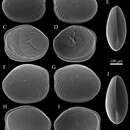Description
provided by Zookeys
Carapace (Figs 2A–E, 3–6). Carapace oval and anteriorly concave in lateral view. Yellowish white colour in living individuals. Carapace periphery surface covered with shallow pits except on posterodorsal area, and with scale-like sculptures on anterior area (Figs 2A, B, 3, 4). Anterior end of both valves with one conspicuous spine (Figs 2A, B, 3, 4). Mid-anterior to posteroventral margin covered with serration and fringe (Figs 2A, B, 3). Posteroventral margin of right valve with four conspicuous spines and fringe (Fig. 5A, B) and of left valve with fine serrations (Figs 2B, 3B). In each valve, 73 simple pores (Figs 4, 5C, D), 23 pore systems involving a circular depression with bifurcated seta (Figs 4, 5C) and two contiguous double pore systems with bifurcated seta (Figs 4, 5D). Adductor muscle scar consisting of three closely spaced scars (Fig. 5E). Marginal infold of each valve developed along anterior to posteroventral margins (Figs 2C, D, 6B, C, J–L). Along hinge margin of right valve: anterodorsal bar and groove (Fig. 6A), anterior socket (Fig. 6E), median bar (Fig. 6F), posterior socket (Fig. 6G), and posteroventral groove (Fig. 6D, H). Along hinge margin of left valve: anterodorsal bar (Fig. 6I), anterior knob (Fig. 6M), median bar (Fig. 6N), posterior knob (Fig. 6O), and posterior bar (Fig. 6P).
Frontal organ (Figs 7A, 8B). Spinous seta divided at mid-length. Distal half with long and proximal half with short setae, respectively (Fig. 8B).
Antennula (Figs 7B, 8C). Uniramous, four articulated podomeres. First podomere rectangular in shape and tapering distally, with setulae on dorsal margin, lateral surface and at ventrodistal end, respectively. Second podomere about four-fifths as long as first podomere, with one annulated setulous seta at dorsoproximal end, one simple seta on ventrodistal end (Figs 7B, 8C), and setulae on dorsal margin, lateral surface, ventral middle margin and at ventrodistal end, respectively. Third podomere about one-fifth as long as first podomere, with one short simple seta at dorsodistal end and one seta with serrations at ventrodistal end (Figs 7B, 8C). Fourth podomere small, with four long setulous annulated setae.
Antenna (Figs 7D, D', 8D). Typically biramous, with exopodite and endopodite consisting of nine and three podomeres, respectively. Basis triangular and tapering distally. Exopodite: first podomere about one–third as long as basis; podomere lengths decreasing in size from second to eighth, each podomere with one long plumose annulated seta, respectively; ninth (distal-most) podomere very small, with one long annulated, one medium annulated and one short bare setae at distal end. Endopodite (Figs 7D, D', 8D): first podomere about two-thirds as long as first podomere of exopodite; second podomere half as long as first podomere, with one setulous seta along dorsal margin, one clavate process at proximal middle end (Fig. 7D') and five setae at distal end consisting of three long annulated, one medium annulated and one short annulated setulous. Third podomere one-fifth as long as first podomere, with one dorsal outgrowth (Figs 7D', 8D), and two long spinous annulated, one long annulated and one short setulous annulated setae at distal end.
Upper lip (Fig. 10A). Semicircular in lateral view, with fine setae on surface (Fig. 13A).
Mandibula (Fig. 10B). Coxal endite with four teeth. Basis with four plumose annulated setae on ventral margin, and one plumose annulated seta at mid-lateral surface. Exopodite pear-shaped, distal end jagged, with thin setae, and one simple seta. Endopodite consisting of two podomeres. First podomere with three annulated plumose setae on ventral margin and two annulated long setulous setae at dorsodistal end. Second podomere very small, bearing two plumose setae at distal end.
Maxillula (Fig. 10C, C', C"). Precoxa (Fig. 10C') with seven annulated plumose setae and one stout setulous seta on ventral side. Coxa (Fig. 10C") with two short and two medium plumose setae on lateral surface near ventroproximal margin, two short and two medium plumose setae on lateral surface of ventral middle margin. Basis rectangular, dorsally-convex in lateral view, with one medium and one long plumose setae on ventral margin, and setulae along ventral margin. First podomere of endopodite with one long plumose seta at ventrodistal end. Second podomere three-fourths as long as first podomere, with two long and one medium annulated setulous setae on ventrodistal area, one short annulated and one medium setulous annulated seta at dorsodistal end. Third podomere small, with 4 long annulated setulous setae. Exopodite with four tufts along dorsal margin, and nine annulated setae at distal end.
Fifth limb (Figs 10D, 11). Coxa bearing branchial plate (epipodite) with 15 long plumose setae, and four short setulous setae on dorsolateral area. Basis with three setulous and three plumose setae on dorsal and ventral margin, respectively. Endopodite consisting of two podomeres (Fig. 11). First podomere with one plumose seta. Second podomere rectangle, with one plumose seta. Exopodite with four setulous setae.
Furca (Figs 12A, 13B). Furcal claws six and seven on left and right lamella, respectively, with row of setae on dorsal side.
Male copulatory organ and posterior body (Figs 12A, 13B–D). Arising from outer surface of body on left side of terminal trunk segment as long curved copulatory duct. Tuft of stout setae at ventral right side (Fig. 12A, 13C). Posterior body including a lot of very long spermatozoa, approximately 750 μm long (Fig. 12A, 13D).
- license
- cc-by-3.0
- copyright
- Hayato Tanaka, Akira Tsukagoshi
- bibliographic citation
- Tanaka H, Tsukagoshi A (2013) Description and scanning electron microscopic observation of a new species of the genus Polycopetta (Crustacea, Ostracoda, Cladocopina) from an interstitial habitat in Japan ZooKeys 294: 75–91
- author
- Hayato Tanaka
- author
- Akira Tsukagoshi

